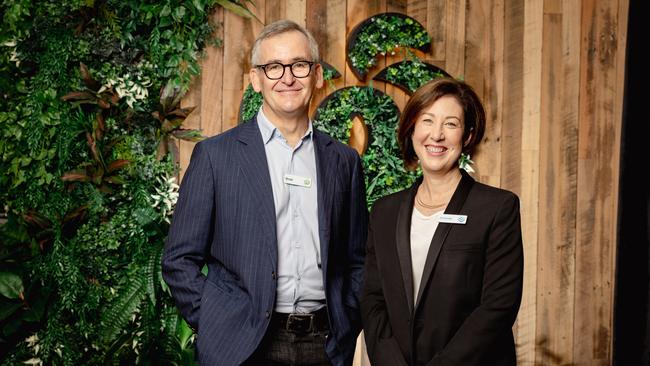Woolworths CEO Brad Banducci backs new boss Amanda Bardwell to turn tables on Coles
Woolworths is trailing arch rival Coles in terms of sales growth but outgoing CEO Brad Banducci believes new boss Amanda Bardwell can make Woolies great again.
Outgoing Woolworths CEO Brad Banducci will hand successor Amanda Bardwell a turnaround challenge after the supermarket fell further behind rival Coles, but says he is confident it can turn the tables on its smaller competitor as it convinces shoppers of its lower prices and greater value.
Mr Banducci, who will depart on Monday after eight years at the helm of the nation’s largest retailer, also warned that the market dynamics of the $100bn-plus supermarket sector had changed markedly during his tenure, with upstart players such as Aldi and Chemist Warehouse also snapping at Woolworths’ heels.
And while he conceded Woolworths needed to do better on convincing shoppers of its lower or more competitive prices, Ms Bardwell would have the tools she needed to play the long game over the coming years and get Woolworths back to its mantle as a trusted home of low prices.
That fightback was already under way, Mr Banducci added.
“Where we have been focused, and where we had that low point in the third quarter, we’ve been working from that of just building back up subsequently and every week our momentum is just a little better and our customer scores a little better and that has continued into the first eight weeks (of 2025),” Mr Banducci told The Australian on Wednesday.
“It’s very hard to opine who is ahead and or not after eight weeks, because it is all about setting the business up for the second quarter, getting into Halloween, Spring Carnival and ultimately the crescendo into Christmas and we are very focused on getting the business right for that.”
Woolworths reported a 93.3 per cent dive in full-year net profit to $108m after booking $1.7bn in impairments related to its stake in drinks group Endeavour and its struggling New Zealand supermarket arm.
Woolworths posted a 5.6 per cent lift in full-year sales to $67.922bn and a net profit – before significant items – of $1.711bn, down 0.6 per cent. The sales and profit for the 2024 fiscal year was broadly in line with consensus forecasts.
Of greater concern to investors was a stronger quarterly sales performance by Coles during the year, especially the second half, which pushed into the start of the current fiscal year. For the second half, Woolworths sales rose 1.8 per cent, and for the first eight week of 2025 hey were up 3 per cent.
n comparison, Coles’s June half sales rose by more than 5 per cent, and it posted sales growth of 3.7 per cent for the first eight weeks of the new financial year.
“After a strong first half, we worked hard in the second half to address rapidly changing customer expectations following the drop in our customer scores in the third quarter and a loss of sales momentum,” Mr Banducci said. “Pleasingly, customer scores and sales momentum improved in the fourth quarter, and this has continued into fiscal 2025.
“Looking ahead, improving customer scores, item growth, and lower inflation provide reason for optimism. However, we also know that our customers remain under significant mortgage and rent-related financial stress and anticipate them to remain cautious with the trading environment expected to be challenging for the rest of the financial year.”

Mr Banducci said he believed that Ms Bardwell, who since 2017 has run the retailer’s digital business and begins her CEO role on Monday, would be able to harness that momentum to take the fight to Coles, but that she would be keeping an eye on other players also competing for shoppers.
“The business has some momentum and just how it continues to build, that’s far more important to me than getting caught up in the competitive set,” he said. “And the retailer that has grown is Aldi, so it’s not really Woolies and Coles, it’s Aldi and Chemist Warehouse and so on of this world, who have taken a portion of our basket – not all of it – and the way we get there is by holding that basket and growing it.
“That’s how we are measuring success.”
And while Woolworths wages that battle against Coles, Aldi, Chemist Warehouse and others, its investors will enjoy a better immediate return – despite the sharp drop in statutory net profit – with Woolworths also announcing on Wednesday a special dividend of 40c a share. The dividend top-up, after its ordinary final dividend of 57c a share was down from 58c in 2023, was funded by $489m raised from the sale of a 5 per cent stake in Endeavour. The dividends will be paid on September 30.
The company’s Australian supermarkets once again did the heavy lifting to drive stronger underlying earnings growth for the company and counter flat sales at its New Zealand supermarket chain and shrinking profitability at Big W.
Mr Banducci said cost-of-living pressures remained top of mind for consumers in the second half. Inflation in its food businesses and Big W moderated significantly as it passed on lower cost prices to customers. Average prices in Woolworths’ food retail in the third quarter and fourth quarter were down 0.2 per cent a 0.6 per cent, respectively, on the prior year.
Within the business, Woolworths supermarkets reported a 5.6 per cent lift in sales to $50.741bn, while earnings rose 8.6 per cent to $3.11bn. On a normalised basis to account for the 53 trading weeks, earnings were up 6 per cent.
At its B2B food business, led by its PFD Food Services arm, sales rose 6.1 per cent to $4.6bn as earnings rose 92.7 per cent to $122m. In August, Woolworths agreed to acquire the remaining 35 per cent of PFD from the founding Smith family.
At Big W, sales fell 2.1 per cent to $4.685bn as earnings dropped 90.4 per cent to $14m. The discount department store struggled due to a sharp retreat in consumer spending on discretionary goods and a highly competitive sector for general merchandise.
Big W’s sales for the first eight weeks were broadly flat on the prior year, with item growth improving but offset by a reduction in average selling price reflecting markdowns to clear its autumn/winter range.
Woolworths shares closed up $1.16, or 3.3 per cent, at $36.62.





To join the conversation, please log in. Don't have an account? Register
Join the conversation, you are commenting as Logout